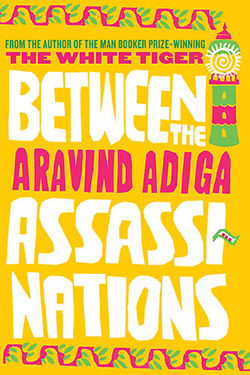Between the Assassinations
by Aravind Adiga
reviewed by Anis Shivani
It is difficult to build on a book as successful as The White Tiger, which won the 2008 Booker Prize, and is a substantial addition to the canon of Indian diasporic writing. The White Tiger is about a hyper-ambitious Indian driver who takes revenge on an unjust economic and political system. Set in the twenty-first century, it describes an India in the throes of globalization, amid the milieu of international call centers and falling bourgeois values.
Adiga has written not so much a follow-up as a shattering of the clear, one-sided lens through which we read The White Tiger. Between the Assassinations is less an expansion of novelistic possibility than a willful step back to explain the raw emotions that went into the earlier book. Where The White Tiger is highly finished, voice-driven, and ferociously cogent and consistent, Between the Assassinations is determinedly un-centered, resists completion, and lacks the idiosyncratic private voice that often characterizes the postcolonial novel now.
While The White Tiger is almost Forsterian in its desire to close the circle of the text, Between the Assassinations stifles closure, leaving everything to chance. This makes sense because whereas The White Tiger is located in a moment in which the fundamental decision to switch to a capitalist economy was already made, “between the assassinations” refers to that nowhere land of the late 1980s when Indira Gandhi had already been assassinated (ending a phase of national certainty handed down from Nehru) and Rajiv Gandhi, her more Western-oriented son, had yet to be assassinated. India truly didn’t know, in those years, where it was going. The linked-story format—which suggests that the propulsion isn’t there to support a full-fledged novel—serves this transitory context well.
In the new book, Adiga tells the same basic story over and over. Someone from the village has come to the city to make his fortune but finds that the limits of caste and class stop him dead in his tracks. Ambition is raw and abundant, but opportunity severely limited. We might view the book almost as a justification for the chaos of post-1991, post-economic liberalization in India. The South Indian town of Kittur, where the stories take place, represents all of India’s linguistic, religious, and cultural diversity, with its Muslim, Christian, and Hindu neighborhoods organized around the timeless principle of segregation. A go-getter from the lower class hinges himself to a rich patron, only to discover that he is useful just as long as he can outcompete the countless others striving to replace him.
In “Day One (Afternoon): The Bunder,” a Muslim factory owner is unable to escape bureaucratic corruption, if he is to keep his workers employed; in “Day Two: Lighthouse Hill,” “Xerox Ramakrishna,” who illegally copies books, stands up against censorship by selling The Satanic Verses; in “Day Two (Evening): Market and Maidan,” two brothers, Vittal and Keshava, consider the choice between abject but consistent employment and taking a risk with a temperamental patron; in “Day Four: Umbrella Street,” Chennaya, the deliveryman, and in “Day Five (Evening): The Cathedral of Our Lady of Valencia,” George D’Souza, the mosquito man, rack their brains to escape the bottom, but are thwarted.
By retelling essentially the same story, Adiga assumes a position midway between patronizing exoticism and illusionary romanticism: we cannot get away from the fundamental reality of half the world’s population getting by on scraps, yet we must not overlook their sheer determination either. Kittur is über-Darwinian, yet moments of compassion among the oppressed workers—the domestic servants, the small-time vendors, the cart pushers, the rickshaw drivers—arise organically from the narrative and are central to the way Adiga wants the privileged Western reader to reposition himself toward the enormity of worldwide poverty.
This is a worthy second book and a tickling promise of what is sure to follow from this supremely confident writer.
Published on June 21, 2013

